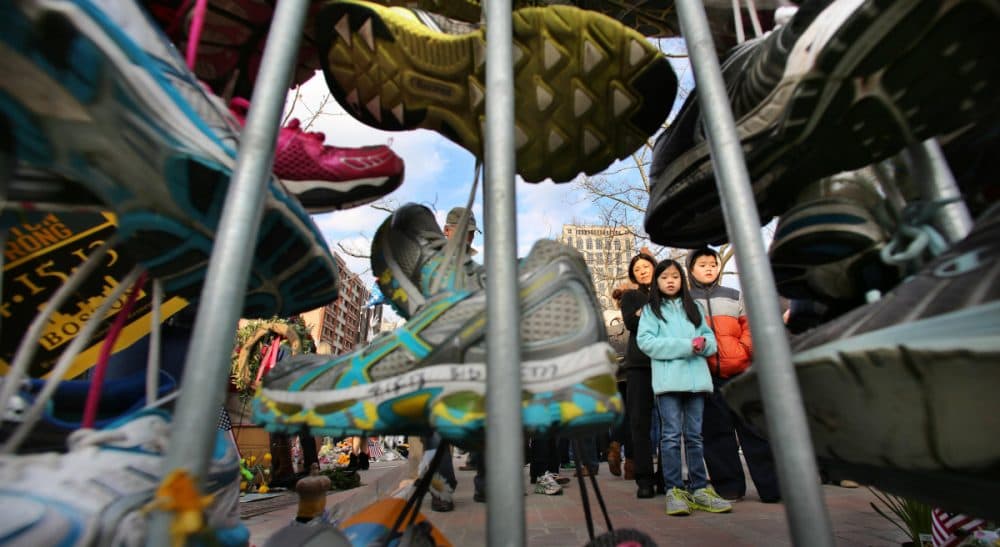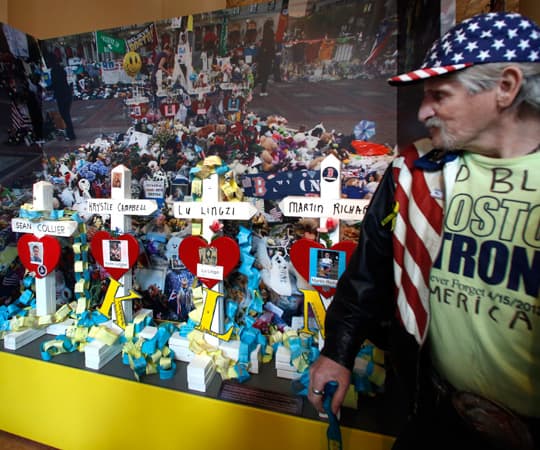Advertisement
Sometimes The Most Eloquent Memorials Are The Least Permanent Ones

It’s an ancient custom to remember our dead and our sites of historical trauma in stone. Gravestones and monuments are holdovers from a time when people stacked simple stones, unengraved and unadorned, to mark the place of souls departed. The impulse may come from a desire for permanence, and while stone doesn’t necessarily last forever, it’s the most durable material nature offers.
Last year’s bombing at the finish line of the Boston Marathon is and will remain one of the most traumatic events in the city’s history. From now on, the most storied footrace in the world, which has always represented the triumph of human will, affords an occasion to reflect on the human capacity for senseless and inexplicable violence. Those victims who were maimed by the violence testify, silently or literally, to the agony they suffered. Those who lost loved ones will always grieve, and will never find an adequate explanation for what happened that day, no matter how often they repeat the crucial question, “Why?”
I’m sure the city will craft a carefully considered, permanent tribute somewhere, but I’d like to sing a note of praise for the spontaneous, temporary shrine that appeared near the marathon finish line last year.
Part of the grieving process is to find a fitting way to memorialize such events in stone and steel. I’m sure the city will craft a carefully considered, permanent tribute somewhere, but I’d like to sing a note of praise for the spontaneous, temporary shrine that appeared near the marathon finish line last year. This random collection of written tributes, American flags, photos, running shoes and shirts, race numbers, stuffed animals and a hodgepodge of other stuff grew in an unruly heap in the weeks after the bombing. Tourists flocked from all over, taking pictures. Locals walked silently through the mess, somber, pointing occasionally at something that moved them. Anyone who (somehow) didn’t know about the bombings would have wondered why so many people were paying attention to what looked like a mound of rubbish, more or less. Why would anyone be moved to tears by an old pair of Nikes?
In June of last year the city of Boston began removing the shrine as wet weather threatened to ruin it. It was hauled in countless boxes to the city archives. Every scrap was preserved. This month the Boston Public Library displays a portion of the shrine in an exhibit named “Dear Boston.”
Initial responses to the exhibit have been positive, but the curators can’t possibly recreate the feeling of the original shrine. It reflected the spirit of the marathon — outdoors, energetic, communal — as well as our city’s mood in the aftermath of the bombings — confused, emotional, inarticulate. Our motto became, immediately, “Boston Strong,” and the stone and steel monument we will eventually create will reflect that resilience. But the shrine, made of paper, cotton, and synthetic nylon, represents another response to the bombings that we should also acknowledge. We felt vulnerable. We felt wounded. We felt humble, and sad, and impermanent.

Spontaneous markers of grief are not always impressive. On 9/11 a group gathered in Davis Square and lit candles — hundreds of them — on a little traffic island. Wax spilled all over the bricks and stone below in an ugly mess. The city of Somerville eventually cleaned it up and replaced it with a small sculpture with an art deco rendering of the Twin Towers to mark that unscripted outpouring of grief and solidarity. I cross that island frequently and I never fail to point out the marker to my sons when they’re with me. They nod politely and say nothing. The small marker, admittedly, is underwhelming. But the memory of the candles and the silent group who lit them stays with me. Wax and candleflame, not stone, seems a fitting and original tribute to the horrifying events of that day.
The same is true of the shrine that sprang up last April. A worn-out running shoe, a teddy bear, and a picture of the smiling faces of the victims are eloquent and powerful reminders of that day and its awful aftermath. The exhibit won’t be on display in the library permanently. All the more reason to visit it this month.
Related:
